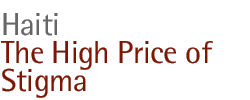Living with HIV (2005)*: 190,000 (3.8% pop.)
Receiving Drugs (2005): 6,500-7,000 (20% of those who need them)
Est. AIDS Deaths (2005): 16,000

Looking back through retrospective research, AIDS first emerged in Haiti in the late 1970s -- the same time it emerged in the United States. As one of the poorest nations in the world -- 65 percent of Haiti's citizens live in extreme poverty -- the small island nation is plagued by severe political instability, endemic diseases including malaria and tuberculosis, and a nearly non-existent national health care system. Haiti had minimal defenses against the onset of the epidemic.
Around the same time the disease was discovered in Haiti, it was also found in Haitians who had migrated to the U.S. in search of a better life. At first, the Centers for Disease Control (CDC) didn't know what to make of it. Dr. Margaret Fischl uncovered some of the first cases among Haitians in Miami. She says the CDC "didn't believe" that her patients were suffering from the same disease plaguing American homosexual men and injection drug users. But by 1982, the CDC named four groups as "risk factors" for HIV infection: homosexuals, heroin addicts, hemophiliacs and Haitians. The stigma conferred by the new disease on all these groups -- who were flippantly designated by some in the popular press as "the 4H Club" -- was immediate and severe, but only in one case did an entire nation suffer the consequences.
"It killed tourism in Haiti," says Dr. Jean Pape, who has been treating AIDS in Haiti since the beginning and who founded the Haitian Study Group on Opportunistic Infection and Kaposi's Sarcoma (known by its Haitian acronym GHESKIO) in May 1982. Tourism formed the backbone of the Haitian economy. "... Within a year the tourism industry decreased by 80 percent," Pape tells FRONTLINE. "Goods manufactured in Haiti could not be sold in the U.S."
Although American public health officials argued that the rates in the Haitian population in the U.S. were high enough to warrant the high-risk designation, Haitian doctors and politicians suggested the labeling was unfair and racist.
An international war of words broke out: U.S. newspapers suggested Haitians brought the disease to America and linked HIV to Haitian voodoo rituals. Haitians said homosexual American sex tourists brought AIDS to their country. The stigma was so severe that Haitians in the U.S. couldn't get work or sell their homes.
During the early years of the epidemic in Haiti, the disease was associated with male homosexual behavior, considered taboo in traditional Haitian society. According to Dr. Pape, doctors were "ashamed" to ask their patients about homosexual activity and patients rarely volunteered that information.
Three years into Haiti's epidemic, AIDS spread to the heterosexual population: Many Haitian males who had sex with other males also had sex with women. Today women comprise half the number of Haitians living with HIV/AIDS.
Despite all the country's problems, Haiti has made remarkable gains in combating HIV, in part because of the development of a broad-based health care system that enlists ordinary citizens to provide health care within their communities. Dr. Paul Farmer, an American physician whose organization Partners in Health pioneered this model in Haiti, operates a community health center in the rural settlement of Cange. His HIV Equity Initiative trains local residents to administer free antiretroviral drugs to AIDS patients; more than 400 community workers have been trained and more than 1500 patients are currently receiving treatment. "I think that's Haiti's lesson," explains Dr. Farmer, "... if you can integrate prevention and care and make sure there's better supervision of patients with the help of community health workers, I think other countries with major AIDS epidemics ... are going to see good results."
And Haiti is seeing good results: According to the latest figures from UNAIDS, Haiti's HIV prevalence rates are dropping: The percentage of pregnant women who have tested HIV positive has declined by half over the last 10 years, and in urban areas, prevalence rates have reduced from 9.4 percent in 1993 to 3.7 percent in 2003/2004. And in 2000, 11 percent of Haitians reported abstaining from sex (twice as many as in 1994) and 45 percent of men and 32 percent of women reported being faithful to a single partner (as compared to 37 percent and 20 percent in 1994).
But the news is not all good: Rates have declined only slightly in rural areas; young Haitians are reporting sexual activity at earlier ages; and only 15 percent of females and 28 percent of males aged 15 to 24 report knowing how to prevent HIV infection. And some of the drop in infection rates may be due to large numbers of people dying.
Despite operating a clinic in one of the most dangerous parts of Port-au-Prince, where one or two murders occur daily outside his office and staff members have been raped, Dr. Pape remains optimistic. "Look at Haiti," he says. "The country is in total disarray and yet we are containing one of the most devastating diseases, which is AIDS."
Dr. Farmer concurs. "You hear bad news about Haiti all the time, and you hear bad news about AIDS all the time, but we can give you some good news about AIDS in Haiti," he says.
* Note: Figures reflect most recent statistics from UNAIDS and the World Health Organization.

